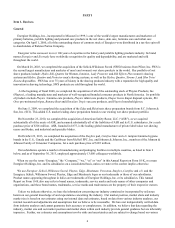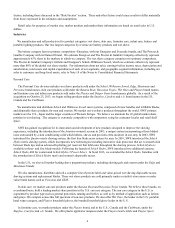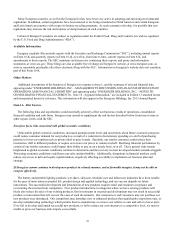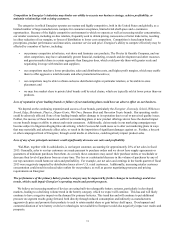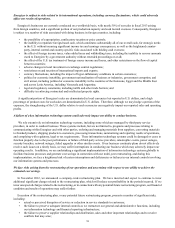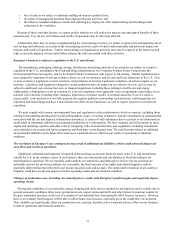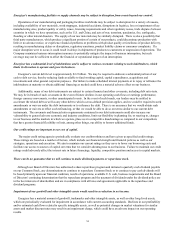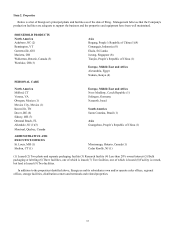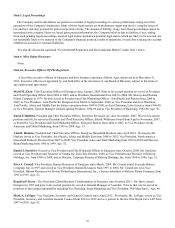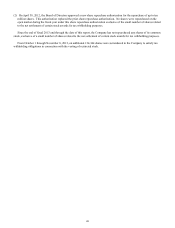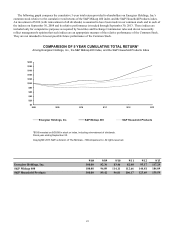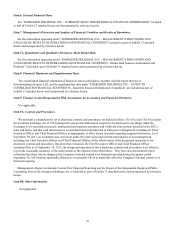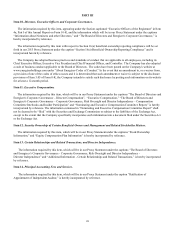Energizer 2013 Annual Report Download - page 23
Download and view the complete annual report
Please find page 23 of the 2013 Energizer annual report below. You can navigate through the pages in the report by either clicking on the pages listed below, or by using the keyword search tool below to find specific information within the annual report.• loss of sales as we reduce or eliminate staffing on non-core product lines;
• diversion of management attention from ongoing business activities; and
• the failure to maintain employee morale and retaining key employees while implementing benefit changes and
reductions in the workforce.
Because of these and other factors, we cannot predict whether we will realize the purpose and anticipated benefits of these
measures and, if we do not, our business and results of operations may be adversely affected.
Additionally, there may be delays in implementing the restructuring activities or a failure to achieve the anticipated levels of
cost savings and efficiency as a result of the restructuring activities, each of which could materially and adversely impact our
business and results of operations. Further restructuring or reorganization activities may also be required in the future beyond
what is currently planned, which could further enhance the risks associated with these activities.
Energizer's business is subject to regulation in the U.S. and abroad.
The manufacture, packaging, labeling, storage, distribution, advertising and sale of our products are subject to extensive
regulation in the U.S., including by the Food and Drug Administration, the Consumer Product Safety Commission, the
Environmental Protection Agency, and by the Federal Trade Commission with respect to advertising. Similar regulations have
been adopted by authorities in foreign countries where we sell our products, and by state and local authorities in the U.S. New
or more restrictive regulations or more restrictive interpretations of existing regulations could have an adverse impact on our
business. Legislative and regulatory changes by taxing authorities have an impact on our effective tax rate, and we may be
subject to additional costs arising from new or changed regulations, including those relating to health care and energy.
Additionally, a finding that we are in violation of, or not in compliance with, applicable laws or regulations could subject us to
material civil remedies, including fines, damages, injunctions or product recalls, or criminal sanctions. Even if a claim is
unsuccessful, is not merited or is not fully pursued, the negative publicity surrounding such assertions could jeopardize our
reputation and brand image and have a material adverse effect on our businesses, as well as require resources to rebuild our
reputation.
We must comply with various environmental laws and regulations in the jurisdictions in which we operate, including those
relating to the handling and disposal of solid and hazardous wastes, recycling of batteries, and the remediation of contamination
associated with the use and disposal of hazardous substances. A release of such substances due to accident or an intentional act
could result in substantial liability to governmental authorities or to third parties. We have incurred, and will continue to incur,
capital and operating expenses and other costs in complying with environmental laws and regulations, including remediation
costs relating to our current and former properties and third party waste disposal sites. We could become subject to additional
environmental liabilities in the future that could cause a material adverse effect on our results of operations or financial
condition.
The resolution of Energizer's tax contingencies may result in additional tax liabilities, which could adversely impact our
cash flows and results of operations.
Significant estimation and judgment is required in determining our tax provisions for taxes in the U.S. and jurisdictions
outside the U.S. In the ordinary course of our business, there are transactions and calculations in which the ultimate tax
determination is uncertain. We are regularly under audit by tax authorities, and although we believe our tax positions are
defensible and our tax provision estimates are reasonable, the final outcome of tax audits and related litigation could be
materially different than that reflected in our income tax provisions and accruals. The unfavorable resolution of any audits or
litigation could have an adverse impact on future operating results and our financial condition.
Changes in production costs, including raw material prices, could erode Energizer's profit margins and negatively impact
operating results.
Pricing and availability of raw materials, energy, shipping and other services needed for our business can be volatile due to
general economic conditions, labor costs, production levels, import duties and tariffs and other factors beyond our control. In
the past, substantial increases in the cost of a number of raw materials have been partially offset by price increases. However,
there is no certainty that Energizer will be able to offset future cost increases, especially given the competitive environment.
This volatility can significantly affect our production cost, and may, therefore, have a material adverse effect on our business,
results of operations and financial condition.
13




